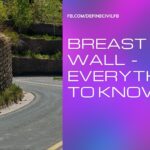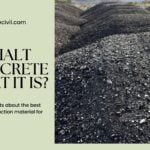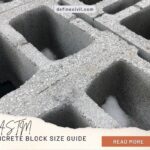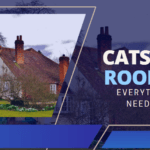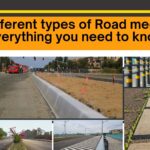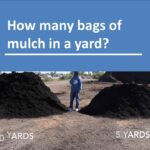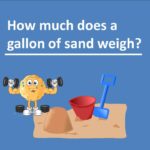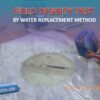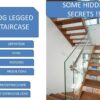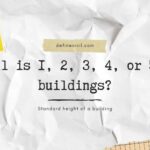Plane table survey is a graphic method of surveying in which field work and plotting are done simultaneously. It is the fastest and easiest method of surveying where great accuracy is not a concern.
It is useful for filling in details between stations fixed by other methods. In plane table survey, no heavy and costly equipment is required. Furthermore, it is less hectic than theodolite survey so long as the area to be surveyed is small.
In this article, we will walk you through various aspects of plane table surveying.
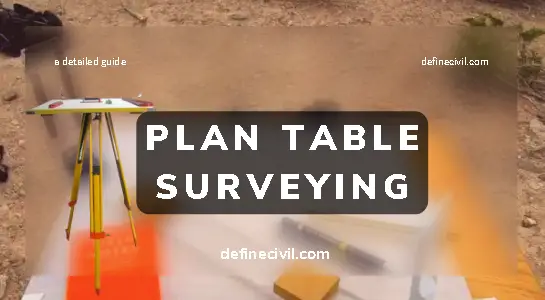
Accessories Used in Plane Table Survey
Following equipment is used in plane table survey.
Drawing Board
It is wooden board made of well-seasoned wood. It is mounted on a tripod stand and can be rotated and clamped in any position according to requirement.
Also Read: Tacheometric Surveying – Principle – Method – Applications – Errors – Advantages
Alidade
It is a ruler like straight edge made of metal. It is used for sighting the point in plane table surveying. One end of the alidade is tapered which is called fiducial edge and the other end is graduated. This graduated edge is used for drawing the line of sight.
It is fitted with side vanes and has narrow slit on one side and a central vertical wire on other side. It comes in two varieties i.e. plane and telescopic.
While plane alidade is used to take horizontal sights, telescopic alidade can measure inclined sights too. Telescopic alidade has greater accuracy than a plane alidade.
Plumb Bob and Plumb Fork
These are used for centering the wooden board. The plumbing fork has two arms; one horizontal and the other inclined.
The horizontal arm is equipped with a pointer at the end and is placed on paper while the inclined arm has a hook from which plumb bob is suspended.
The wooden board is shifted manually until the plumb bob is positioned exactly over the peg of the station.
Trough Compass
It is used to navigate the terrain in which survey is being done. It determines the bearing of the land. It is also used in orientation of plane table.
Spirit Level
Apart from centering, the plane table needs levelling to ensure accuracy of work. Levelling makes sure that the drawing board remains exactly parallel to the ground. This is done with the help of a spirit level.
Drawing Sheet
It is the paper sheet on which drawing is done.
Water Proof Cover
Water proof cover is essential because the drawing board and sheet are in open. In case it rains, it will spoil the sheet. Therefore, it is advisable to always bring some kind of water proof cover on the site.
Setting up Plane Table
Basically three adjustments are to be done before starting plane table surveying.
Centering
Centering is done to make sure that every point on ground is marked exactly on the paper. As discussed earlier, it is done with the help of a plumbing fork and a plumbing bob.
Also Read: Ranging in Surveying – Direct Ranging – Indirect Ranging – Line Ranger [PDF]
Levelling
Levelling assures that the drawing board remains parallel to the ground all the time. If the board is not parallel, readings will be different from true readings. Levelling is done with a spirit level. A spirit level is placed on the table and the table is moved manually until the bubble in the level is exactly at the center of the level.
Orientation
In plane table surveying, the table has to be moved at different locations to complete the survey. When the table is positioned at a new station, it is mandatory that the new station remains parallel to the previous one.
If not done properly, the lines drawn on the paper will not represent the same lines on the ground. There are two methods of orientation:
By trough compass: This is not an accurate method. It is generally used when it becomes impossible to bisect the previous station from the new station. This method is not commonly used.
By back sighting: This is the most accurate method of orienting a plane table. A back sight is a point of known location. After the plane table is fixed on a new station, alidade is placed against the line joining the new station and the previous station. The table is then rotated until the new line of sight bisects the previous station.
Methods of Plane Table Survey
Radiation
It is used when all points on the field are visible from a single point. In radiation, the plane table is not moved from one station to other. It is also the simplest method of plane table surveying.
Also Read: Difference between Plane Surveying and Geodetic Surveying
Procedure
Suppose there is a point O at which plane table has been set. From point O, point B, C, D, E, and F are visible. After the plane table has been set up, out alidade on point O and draw a line of sight for station B.
After the distance OB has been measured on field, draw it on paper to a suitable scale. Same procedure is applied to points C, D, E, and F. Finally, all these points are joined on the paper.
Traversing
A traverse is a series of connected lines whose lengths and directions are to be measured. Plane table traversing is similar to theodolite or compass traversing. It is used for running survey lines between stations that have been previously fixed by other stations (control points).
Procedure
Suppose the plane table is set at a location A. From point A, a sight is taken towards another point B and the distance AB is measured. After that, the plane table is moved to station B and back sighting is done i.e. distance BA is measured. The average of these distances is plotted on scale. Similar process is repeated on all other stations.
Check Line: A check line is used to measure the accuracy of work. The length of check line as measured on the ground should be same as that on the map.
Intersection
This method is suitable in hilly terrains or when some kind of obstruction between points does not allow direct measurement.
Also Read: Digital Level Surveying – Advantages – Component – Types
Procedure
Suppose two points O1 and O2 are selected and these points have good visibility. After setting up is done at point O1, orientation is done at station O2. The distance O1O2 is measured and plotted on the paper. From station O1, rays are sighted to points A and B.
After that, table is shifted to a new station. After orienting the table at new station, points A and B are sighted and drawn. The intersection of rays from stations O1 and O2 will give points A and B on paper.
Resection
This method is used to add in missing details from previously established stations. This is done by establishing new stations at a place and locate missing details.
Advantages
- Suitable for small scale mapping.
- Rapid and cheap method.
- Comparison with ground all the time, thus better accuracy.
- Exact representation of ground.
- Errors can be easily detected by check lines.
- No special skills are required.
Also Read: Chain Surveying – Principles of Chain Surveying
Disadvantages
- Work only possible in normal weather conditions. You can’t survey using plane table in rainy or wet climates. This method is also not suitable for area in high winds.
- Equipment is heavy.

